
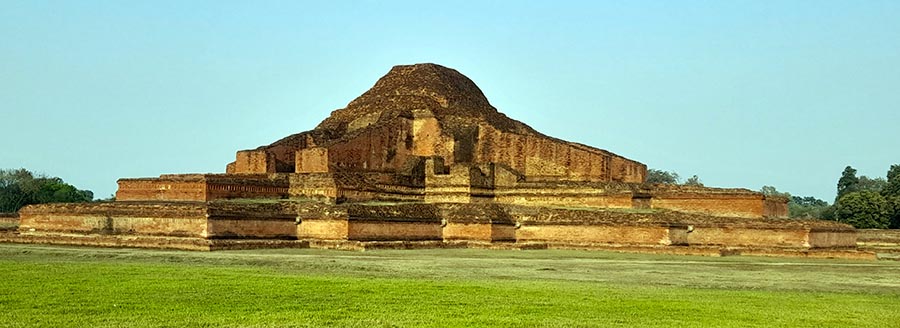
The Rajshahi, Bogura, Naogaon and Nawabganj districts of Bangladesh are adjoining to Malda and Murshidabad districts of West Bengal. The districts have a rich share of heritage and history. Known for the Unesco Heritage Sites of Somapura Mahavihara (locally known as Paharpur Vihar), the region comprises several other Buddhist ‘viharas’ along with medieval period mosques and temples with intricate terracotta ornamentation. But no tour of Bangladesh is complete without its share of amazing food
All photographs by the author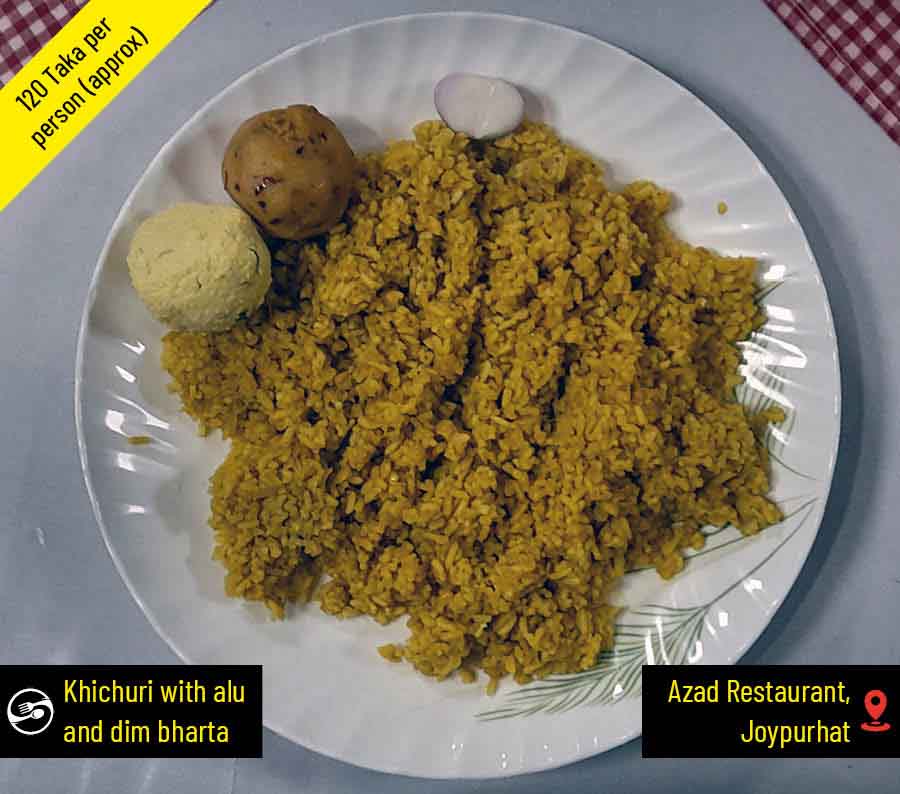
The day in this part of Bangladesh normally starts with a plate full of khichuri paired with alu and dim bharta (mashed boiled potato and egg). The khichuri has different variants and comes with atop (fine) and mota (coarse) chaal (rice). The khichuri is a filling one-pot meal and ideal for travellers who plan for a late lunch or even skip lunch. People with big appetite can add an extra omelette and the entire course can be gulped down with a cup of tea

A khichuri at breakfast every day is no joke and needs a strong stomach to digest. For those wishing different taste can opt for a complimentary breakfast at Parjatan Motel, an initiative of Bangladesh Parjatan Corporation. These motels are located throughout the country and operate on a bed-and-breakfast model. The breakfast comes free but it is not a buffet. The typical morning meal consists of paratha. Mixed veg and booter (cholar) dal along with a choice of egg (fried or omelette). Tea or coffee is included
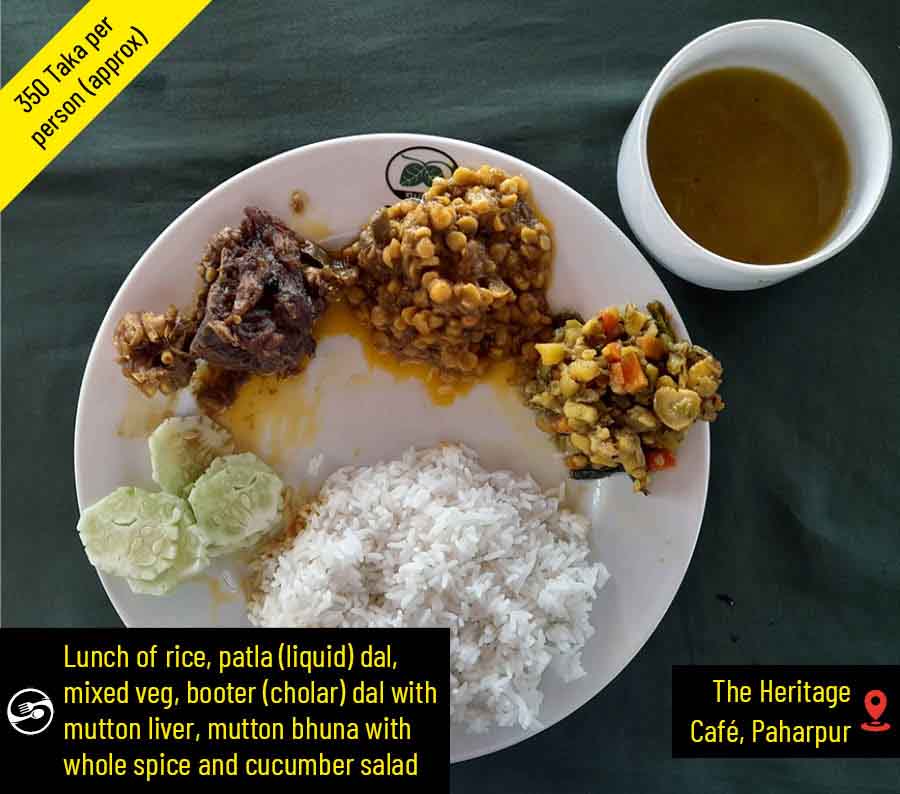
Lunch in Bangladesh typically consists of dal and rice. The dal again comes in two varities, one is free-flowing and is mixed with rice. The other is booter dal (known as cholar dal in West Bengal). The booter dal comes in non-vegetarian version and has a dash of mutton liver or mashed fish head along with bones. The mixed vegetables consist of an assortment of seasonal vegetables. But no meal in Bangladesh is complete with a non-vegetarian item of fish and meat. The mutton bhuna in the Paharpur region is cooked with whole spices and include cardamom, cloves and even whole garlic. But the best part of the Heritage Café goes beyond food. It is located with the complex of a Unesco Heritage Site and the towering stupa can be viewed from the café while enjoying your delicious lunch
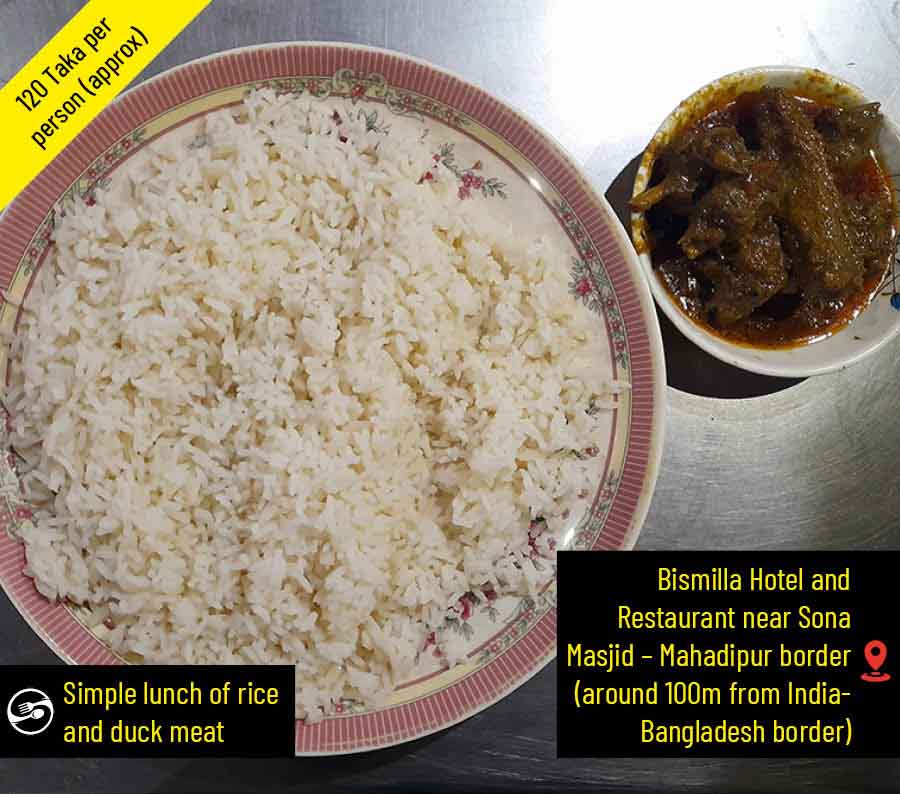
If you are tired of eating and want to keep the lunch simple, Bangladesh has a wide range of options. These simple meals are served in small eateries all throughout the country and comprise mainly rice and an assortment of vegetarian and non- vegetarian items. The one near Sona Masjid – Mahadipur border serves excellent duck meat. For tourists entering or leaving Bangladesh through the Sona Masjid – Mahadipur border, this will be the ideal place for the first or last meal in Bangladesh. No wonder it would be a great way to celebrate the beginning and end of the culinary heritage of Bangladesh

The Chunnu Chap and Kebab Ghar in Bogura is an amazing place offering a unique combination of deep-fried beef with luchi. The piece of beef is first hammered into a thin sheet and coated with a thick layer of batter. It is then deep fried and served with luchi and shredded onion. Fried chicken (cooked in similar pattern) is also on the menu. The food is usually gulped down with cold soft drinks. Apart from the food the place is an experience in itself. During dinner time, hungry souls stand outside the shop munching on the deep fried chnaaps
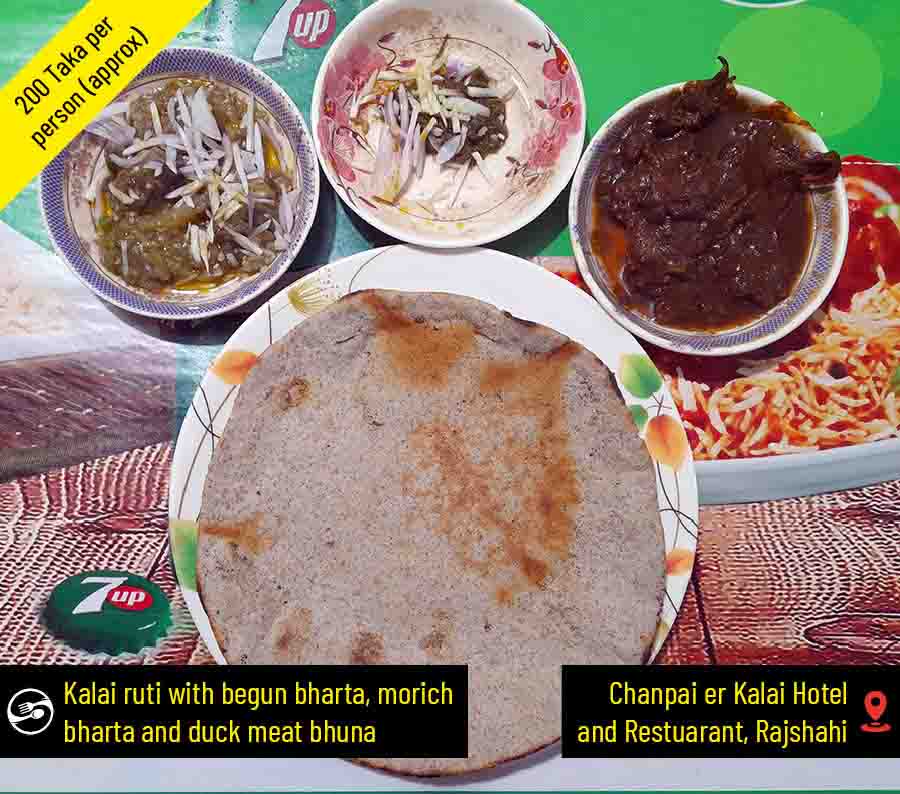
Kalai ruti is a special kind of bread made of black gram (mashkalai) and other kinds of flour. It is rich in carbohydrates and protein. For centuries, kalai ruti and begun bharta have been a food of the working-class people of Rajshahi. Today, it has been turned into an exotic fine dining item and often served with duck meat bhuna. Morich (morich is the term for chilli in Bangladesh) bharta is also part of the platter

Nihari will definitely ring an early morning bell for Kolkatans. The delicacy is served in the wee morning hours of the chilly winter in Kolkata but it is different from Bangladesh. Nihari is available round-the-clock and throughout the year in Bangladesh. The Nihari in Rajshahi is different than its Kolkata counterpart and usually served with a chunk of bone loaded with marrow. The marrow is ejected and mixed with the soupy gravy thus adding flavour to the hot soupy gravy
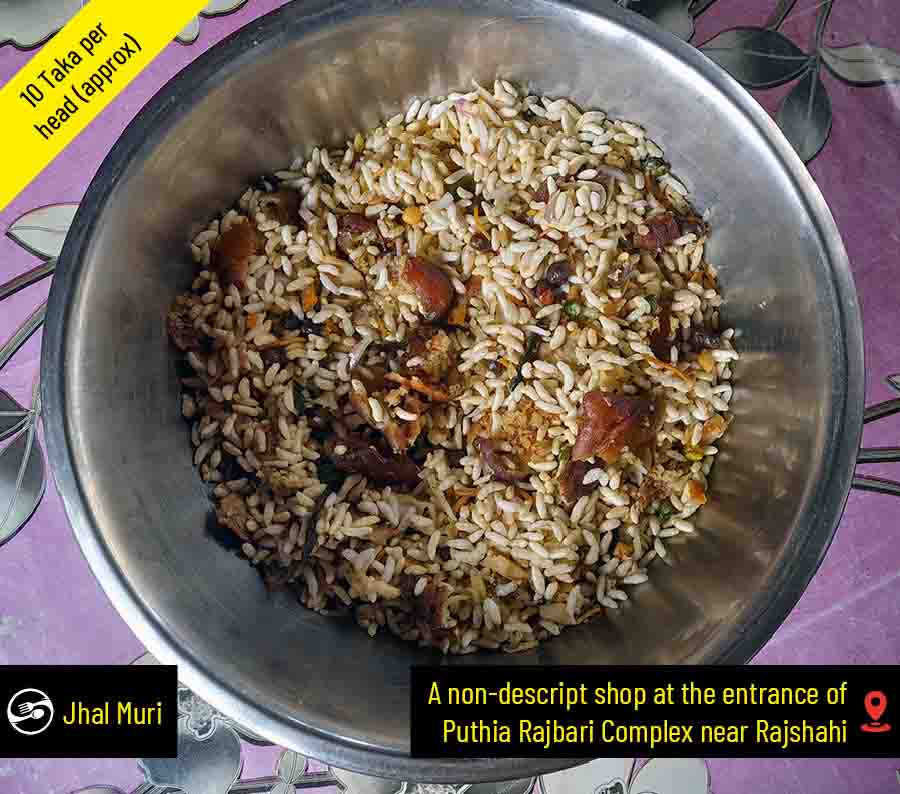
The humble jhal muri has made its way across the border. The only difference is that the Bangladesh version is added with mashed aloor chop and peyanji. Usually, a large dash of mustard oil is added to provide a pungent flavour
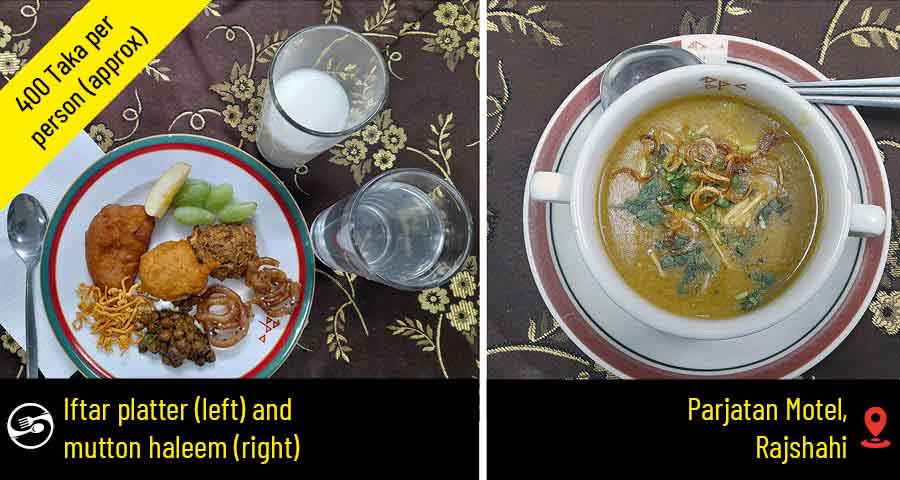
Travelling in a Muslim majority country during Ramzan has its ups and downs. Many of the restaurants are closed during the day. Eating and drinking water in public places is best avoided but an iftar feast is not to be missed. It is open to all people, including those who are not fasting. Many of the hotels, including the Parjatan Motels serve iftar platter, which comes with an assortment of vegetarian fritters and seasonal fruits and dates. It also includes muri (puffed rice), boiled chana along with a sorbet of lime and sugar. Items such as ghol and haleem can be added at an extra cost. The mutton haleem is bit different from the Kolkata variety and is lighter and contains small pieces of tender mutton. It is garnished with golden brown fried onions, shredded ginger and coriander leaves
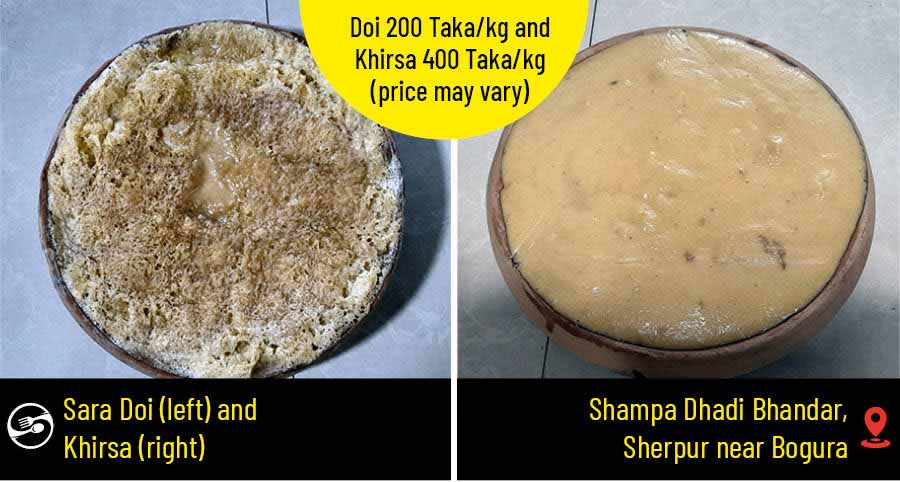
A Bengali meal is never complete without a sweet ending. No trip to Bangladesh is complete without sweets. The town of Bogura is known for its exotic curds and are available in two varieties, namely – Sara Doi and Khirsa. The word ‘sara’ refers to a shallow earthen container on which the curd (doi) is made. It comes in with a hard brown-coloured crust on top. Khirsa is also available in a ‘sara’ and is not a curd but a thick sweetened kheer. Although Bogura is said to be the origin of the two sweet items, they are actually made at Sherpur, a small town slightly south of Bogura. The highway on either side of Sherpur is lined with doi shops and there are several shops by the name of Shampa. The original Shampa shop owned by Gopal Chandra Ghosh is difficult to find and lies behind the rows of shops adjacent to the highway